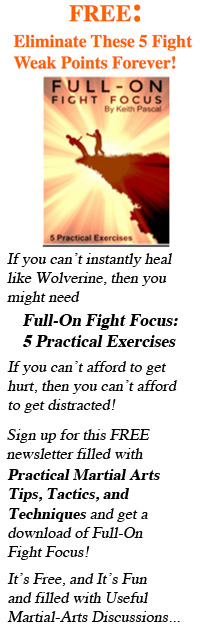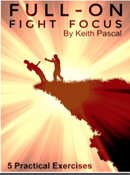Fighting with Eyes Closed
This article isn’t simply about fighting with ones eyes closed. It concludes with a much more important consideration….
You have to admit, there is a certain “coolness factor” to the whole superhero idea of fighting with your eyes closed.
My fascination probably began with the TV show Kung Fu. Kwai Chang Caine (David Carradine) got dirt thrown in his eyes by the outlaws and was still able to fight … after a brief flashback to his blindfold training at the Shaolin Monastery.
From there, I read Eugen Herrigel’s books … specifically, Zen in the Art of Archery. Those masters even turned their heads away from the target as they shot. They simply knew that they’d get their bullseye.
Wow.
.
.
Blindfolded Tae Kwon Do Training
For a year or so, I attended a Tae Kwon Do school that allowed us to go out on the floor blindfolded. It was a travesty; nobody could sense anyone else. You got bruised. And I’m not sure exactly what the teacher intended for us to learn.
That was a mess. If I didn’t have contact, I couldn’t tell who was hitting from where.
.
.
Longstreet
During that period, I also got to see Longstreet with James Franciscus and … Bruce Lee. In it, Longstreet was blind and got to train in JKD. (Another “Wow” is in order.)
JKD, Wing Chun, and Chi Sao
Finally, I found an original Bruce Lee student. And this man, Steve Golden, had us train in Chi Sao (Sticking Hands). We’d touch both wrists to our opponent’s and “roll” (pivot to the range of of the arms twisting ability) back and forth neutrally, until one of us attacked.
Since this occurred from touching, we didn’t have to rely on sight. Touch alone was enough. The lights would get turned off, and we were also instructed to close our eyes.
While some might consider the task of fighting blind difficult, I found that it allowed me to …
.
Eliminate Distractions
With my eyes closed, I only focused on what was relevant to the action. I felt …
- body position
- arm pressure
- opponent’s center of gravity
- opponent’s centerline
And I was able to see in my mind what his feet were doing, the reach of the opponent’s arm that was detaching itself from touching my wrist, and so on.
.
.
The Ultimate in Martial Arts
This was a great feeling for martial training. No distractions. Only focus on the really relevant aspects of my opponent’s attack and defense.
.
~BUT~
.
As soon as I opened my eyes, the focus vanished. All of the external, visual stimuli had returned. In fact, even sounds were distracting me, once again.
So, I’d close my eyes … and the visual mess vanished. The sounds as distractions faded, as well. They were still, there, but they somehow seemed less distracting. I relied on touch, not sound fakes.
Then, I’d open my eyes, and the feeling of intense concentration slipped away.
This went back and forth, until I eventually started to “see” (pardon the pun), some progress.
Eventually, I learned to open my eyes and have the same relaxed focus that I had with my eyes closed. It made no difference whether I was looking or not. (In fact, all these years later, it’s hard to remember the time, when it did make a difference.)
.
.
Target or Technique?
In a real fight, there is so much to take in. Should you focus on what you are trying to hit (I know, there is no “try” Yoda … and Bruce Lee), or should you focus on the hands and feet that are trying to take your head off, or should you focus on your own technique?
First, let’s talk technique….
Try NOT to focus on my technique in the middle of a fight. The time to train technique is during practice. When you are in a real altercation, your body responds … hopefully with the best techniques possible. As Bruce Lee said, “I don’t hit; it [the punch] hits all by itself.”
.
.
Focus on the Enemy
Even knowing that you are focusing on the enemy, there could still be a lot to deal with:
- timing
- distance
- feet kicking
- verbal distractions (threats?)
- punches
- elbow strikes
- eye jabs
- spitting
- third-party distractions (music, other people, other attackers)
What should you do (besides buying all of my ebooks and books)?
Find your own “Chi Sao.”
Sticking (or Sticky) Hands is perfect for training what to do once you are touching your opponent. What you need is your own drill or exercise that eliminates distractions for you. Find a practice exercise that limits the responses, but “keeps it real.”
Search for drills that zero in on what’s important in a fight.
Find ways to practice where not only do you avoid getting distracted, but you aren’t susceptible to fakes, either.
So, when I say “chi sao,” I really mean your own exercise that will help you be more direct and focused in real encounters.
And if you develop a superhero skill or two along the way, the more power to you (zeugma intended).
Keith Pascal
.
.
.
Tags: bruce lee, chi sao, develop practice drills, eyes closed, fighting blind, fighting with eyes closed, longstreet, martial-arts practice, martial-arts visualization, steve golden, sticking hands, sticky hands, tactics, wing chun



For about 2 years I had the privilege of studying Kung Fu San Soo with Master Greg Jones here in Eugene.
One of the seminars that the school put on on occasion was called “darkness training”. In it, along with a number of other skills, we learned a method of moving in the dark (a pitch black room-no blindfold) while “clearing” a room.
At the end of the class we had a “final exam” that involved clearing a room covered with obstacles, blaring music and the instructor somewhere in the room blinding swing a fat Wiffle Ball bat.
Because of the nature of the training and the adrenaline involved I don’t think I will ever forget the techniques and lessons learned during that class. Definitely one of the best training experiences in my martial arts career!